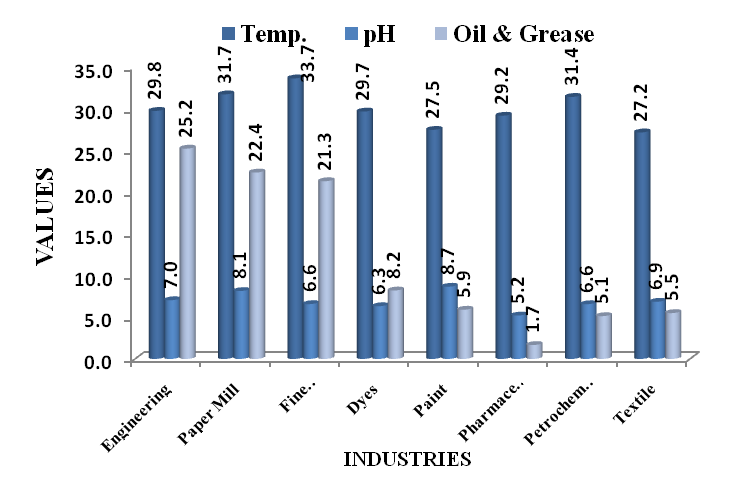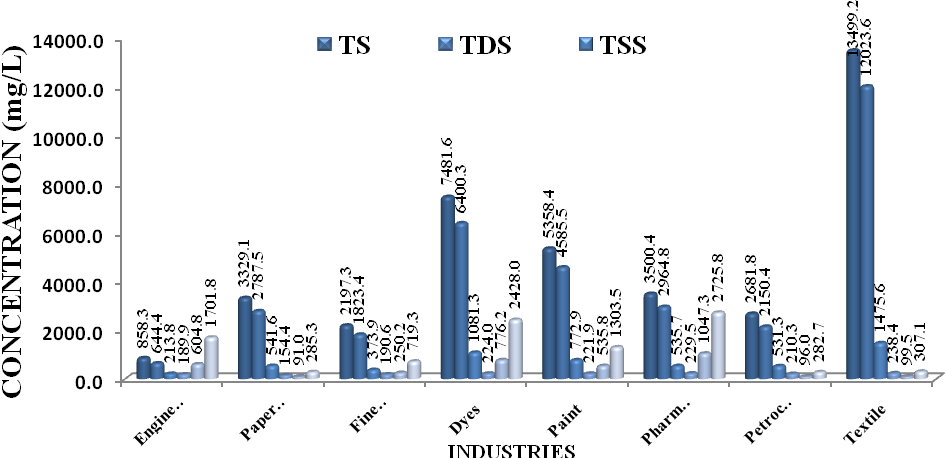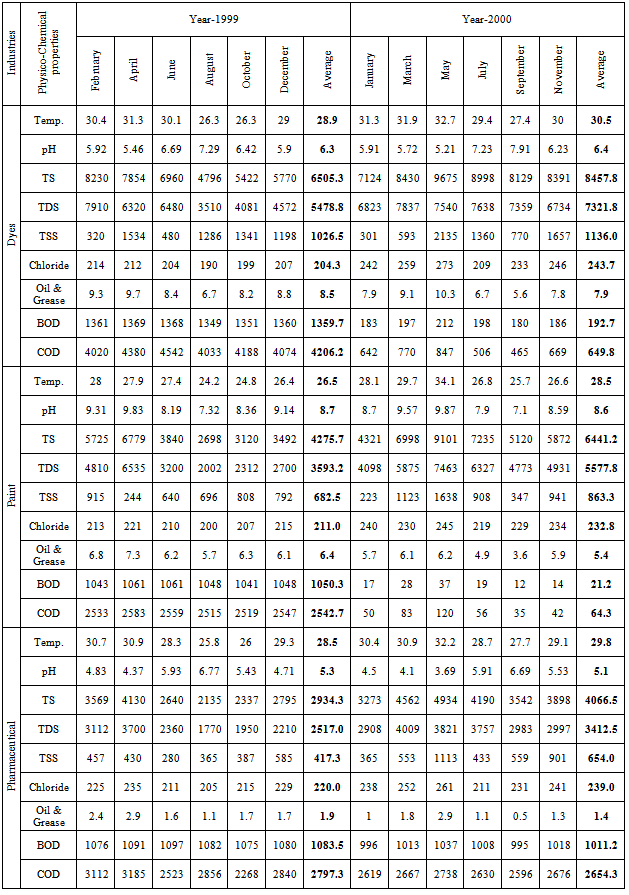-
Paper Information
- Paper Submission
-
Journal Information
- About This Journal
- Editorial Board
- Current Issue
- Archive
- Author Guidelines
- Contact Us
International Journal of Ecosystem
p-ISSN: 2165-8889 e-ISSN: 2165-8919
2011; 1(1): 1-9
doi:10.5923/j.ije.20110101.01
Study on Physico-Chemical Parameters of Waste Water Effluents from Taloja Industrial Area of Mumbai, India
Ram S. Lokhande1, Pravin U. Singare2, Deepali S. Pimple3
1Department of Chemistry, University of Mumbai, Santacruz, Vidyanagari, Mumbai, 400098, India
2Department of Chemistry, Bhavan’s College, Munshi Nagar, Andheri (West), Mumbai, 400058, India
3Department of Chemistry, R.J. College, Ghatkopar, Mumbai, 400086, India
Correspondence to: Pravin U. Singare, Department of Chemistry, Bhavan’s College, Munshi Nagar, Andheri (West), Mumbai, 400058, India.
| Email: |  |
Copyright © 2012 Scientific & Academic Publishing. All Rights Reserved.
The present research work deals with the study of some of the important physico-chemical parameters of industrial waste water effluents collected from Taloja industrial belt of Mumbai. The study reveals that engineering, paper mill, fine chemical, dyes, paint, pharmaceutical, petrochemical and textile industries are some of the major industries responsible for polluting the surrounding aquatic environment. It was observed that pH values of effluent samples collected from paint, pharmaceutical and dyes industries were slightly above and below the limit of 6.5 to 8.5 by ISI and WHO. The effluent samples collected from textile industries shows extremely high Total Dissolved Soild (TDS) content of 12023.6 mg/L and correspondingly high Total Solid (TS) content of 13499.2 mg/L. The chloride content in the effluents from textile industries was 238.4 mg/L which was significantly high than acceptable limit of 200 mg/L set by WHO. The BOD values of effluent samples collected from pharmaceutical, dyes, engineering and paint industries were 1047.3, 776.2, 604.8 and 535.8 mg/L respectively which lie above the maximum permitted BOD content of < 100 to 300 mg/L. The COD values in the different industrial effluent samples were also very much higher than maximum permissible limit of 4.0 mg/L according to USPH Standard. The overall results highlight towards the discharge of highly polluted waste water effluent from industries of Taloja Industrial area of Mumbai. These industrial effluents have resulted in pollution of nearby Kasardi River thereby affecting the growth of vegetation and aquatic life. The results of the present investigation point out the need to implement common objectives, compatible policies and programmes for improvement in the industrial waste water treatment methods.
Keywords: Physico-Chemical Parameters, Water Pollution, Industrial Effluent, BOD, COD, Oil and Grease, Total Solid Content, TDS, TSS, Taloja Industrial Area, Mumbai
Cite this paper: Ram S. Lokhande, Pravin U. Singare, Deepali S. Pimple, Study on Physico-Chemical Parameters of Waste Water Effluents from Taloja Industrial Area of Mumbai, India, International Journal of Ecosystem, Vol. 1 No. 1, 2011, pp. 1-9. doi: 10.5923/j.ije.20110101.01.
Article Outline
1. Introduction
- Waste management strategies adopted in India have failed to keep pace with the industrial growth and urbanization. The pollution impacts on marine communities[1,2] can be traced directly to the industrialized centers, which release an array of chemical contaminants to effluent systems. Of even greater concern have been the adverse environmental effects associated with waste disposal activities, particularly sewage sludge and dredged spoil dumping, oil spills and leakages as well as municipal and industrial waste water discharges. Most of the industries in India are situated along the river banks for easy availability of water and also disposal of the wastes. These wastes often contain a wide range of contaminants such as petroleum hydrocarbons, chlorinated hydrocarbons and heavy metals, various acids, alkalis, dyes and other chemicals which greatly change thephysico-chemical properties of water. The waste also includes detergents that create a mass of white foam in the river waters. All these chemicals are quite harmful or even fatally toxic to fish[1-3] and other aquatic populations[4]. It is found that one-third of the total water pollution in India comes in the form of industrial effluent discharge, solid wastes and other hazardous wastes. Out of this, a large portion can be traced to the processing of industrial chemicals and to the food products industry. The surface water is the main source of industries for waste disposal. Untreated or allegedly treated effluents have increase the level of surface water pollution up to 20 times the safe level in 22 critically polluted areas of the country. It is found that almost all rivers are polluted in most of the stretches by some industry or the other[5,6]. Some of the previous studies in the Arabian Sea have shown that the petroleum hydrocarbons ranged from 1.8 to 11.1 mg/L in water, 1.84 to 5.81 mg/g dry wt in sediments and 0.33 to 3.67 mg/g wet wt in fish[7], while the total DDT in zooplankton samples in the Arabian Sea[8] varied from 0.083 to 0.563 mg/L.Although all the Indian industries function under the strict guidelines of the Central Pollution Control Board (CPCB) but still the situation of environmental pollution is far from satisfactory. Different norms and guidelines are given for all the industries depending upon their pollution potentials. Most of the major industries have treatment facilities for industrial effluents. But this is not the case with small scale industries, which cannot afford enormous investments in pollution control equipment as their profit margin is very slender. Consequently, the water pollution problem particularly due to toxic heavy metals has become menacing concern. As a result in India there are sufficient evidences available related with the mismanagement of industrial wastes[9-14].Previous data on water pollution along creeks and rivers [6,15-26] points out to the need of systematic and regular monitoring of pollution level for further improvement in the industrial waste water treatment methods. The day by day increasing tremendous industrial pollution in India has prompted us to carry the systematic and detail study of physico-chemical properties of industrial waste water effluent from the Taloja Industrial belt of Mumbai.
2. Materials and Methods
2.1. Area of Study
- The study was carried at the Taloja industrial area which is one of the most rapidly developing and heavily polluted industrial belts of Mumbai. The industrial area is spread over 863.18 hectares of land consisting of about 600 large and medium scale industries like engineering units, steel processing industries, chemical units, paints, pharmaceutical units, textile industries etc. The study area lies between latitude 19°3'39"N longitudes 73°6'57"E. The main water source for the industrial consumption is Maharashtra Industrial Development Corporation. The industrial area utilizes about 45,000 m3/day of fresh water. The treated and untreated effluent discharge amounts to 28,750 m3/day i.e., 64% of the total industrial effluents. This has created health hazards not only for local population but also resulted in disturbances of aquatic life of the Kasardi River flowing near the industrial area[6].
2.2. Climatic Conditions
- The weather of the study area is typical coastal sultry and humid. The average rainfall records from 1,500 mm to 2,000 mm. The place experiences the onset of the monsoon in the month of June and experiences monsoon till the end of September. The average temperature recorded varies from 25 to 42 degrees.
2.3. Requirements
- All the glassware, casserole and other pipettes were first cleaned with tape water thoroughly and finally with de-ionized distilled water. The pipettes and burette were rinsed with solution before final use. The chemicals and reagent were used for analysis were of analytical reagent grade. The procedure for calculating the different parameters were conducted in the laboratory.
2.4. Industrial Effluent Sampling and Preservation
- The industrial waste water effluent samples were collected randomly twice in a month in morning, afternoon and evening session from different industries like engineering industries, paper mills, fine chemical manufacturing industries, dyes industries, paint industries, pharmaceutical industries, petrochemical industries and textile industries of Taloja Industrial belt. For each type of industry three representative units was selected. The samples were collected every alternate month from February 1999 to November 2000. The sampling was done in three shifts i.e. morning shift between 07:00 a.m. to 09:00 a.m., afternoon shift between 02:00 p.m. to 04:00 p.m. and evening shift between 07:00 p.m. to 09:00 p.m. Polythene bottles of 2.5 L and 2.0 L were used to collect the grab water samples (number of samples collected, n = 19). The bottles were thoroughly cleaned with hydrochloric acid, washed with tape water to render free of acid, washed with distilled water twice, again rinsed with the water sample to be collected and then filled up the bottle with the sample leaving only a small air gap at the top. The sample bottles were stoppard and sealed with paraffin wax.
2.5. Physico-chemical Study
- The samples were collected were analyzed for temperature, pH, Total Solids(TS), Total Dissolved Solids(TDS), Total Suspended Solids (TSS), chloride content, oil /grease, Biochemical Oxygen Demand (BOD) and Chemical Oxygen Demand(COD) values. The techniques and methods followed for collection, preservation, analysis and interpretation are those given by Rainwater and Thatcher[27], Brown et al[28], ICMR[29], Hem[30] and APHA[31].
3. Results and Discussion
- The experimental data on physico-chemical properties of water samples collected from different industries of Taloja industrial estate of Mumbai is presented in Tables 1, 2 and 3.Temperature is one of the most important ecological features. It controls behavioural characteristics of organisms, solubility of gases and salts in water. The basis of all life functions is complicated set of biochemical reactions that are influenced by physical factors such as temperature. Disease resistance is also linked to temperature. Increase in temperature also increases the rate of microbial activity. Temperature increase may become barrier to fish migration and in this way seriously affect on reproduction of species. The major sources of thermal pollution are industrial cooling systems working in a manufacturing plant or a power plant. In the present study, the biyearly average temperature of industrial effluents varies between minimum of 27.2 ℃ for the effluents from textile industries and maximum of 33.7 ℃ for the effluents collected from fine chemical industries (Figure 1).pH is a measure of the acidity or alkalinity of water and is one of the stable measurements. pH is a simple parameter but is extremely important, since most of the chemical reactions in aquatic environment are controlled by any change in its value. Anything either highly acidic or alkaline would kill marine life. Aquatic organisms are sensitive to pH changes and biological treatment requires pH control or monitoring. The toxicity of heavy metals also gets enhanced at particular pH. Thus, pH is having primary importance in deciding the quality of waste water effluent. Waters with pH value of about 10 are exceptional and may reflect contamination by strong base such as NaOH and Ca(OH)2[32]. The range of desirable pH of water prescribed for drinking purpose by ISI [33] and WHO[34] is 6.5 to 8.5. The biyearly average pH values of effluent samples collected from different industrial units vary between minimum 5.2 in the effluent collected from pharmaceutical industries and maximum of 8.7 in the effluent samples collected from paint industries. In both the cases, pH values were slightly below and slightly high above the permissible limit. The biyearly average pH value of the effluent sample collected from dyes manufacturing industries was observed to be 6.3 which lie slightly below the permissible limit (Figure 1).
 | Figure 2. Variation in average values of total solids, chloride, BOD and COD content in the effluent samples collected from industries of Taloja industrial area for the assessment year 1999-2000 |
|
|
|
4. Conclusions
- Around the world as countries are struggling to arrive at an effective regulatory regime to control the discharge of industrial effluents into their ecosystems, Indian economy holds a double edged sword of economic growth and ecosystem collapse. The present experimental data indicates high level of pollution along Taloja Industrial belt of Mumbai. The experimental data suggests a need to implement common objectives, compatible policies and programmes for improvement in the industrial waste water treatment methods. It also suggests a need of consistent, internationally recognized data driven strategy to assess the quality of waste water effluent and generation of international standards for evaluation of contamination levels. The existing situation if mishandled can cause irreparable ecological harm in the long-term well masked by short term economic prosperity.
ACKNOWLEDGEMENTS
- The authors are extremely thankful to SAP Productions for developing and maintaining the manuscript template.
 Abstract
Abstract Reference
Reference Full-Text PDF
Full-Text PDF Full-text HTML
Full-text HTML


